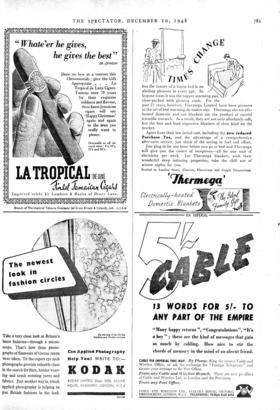Nash, Kokoschka
THE " picture-book " upon which Paul Nash was engaged towards the end of his life now appears, with shifted emphasis and slightly hushed air, as a memorial volume, with a two-colour Latin inscription reprinted from Signatitre ' • a claim that his range may compare with that of Picasso; and such a wealth of technical information that we are told that "out of doors he drew seated on die grass, or on a fence, resting his paper across his knees." Notwithstanding the price of the volume, half the colour plates have had to be begged or borrowed froth other publishers. They are consequently of all shapes and sizes, and have been mounted-upon a heavy -coloured paper with such tenacity as to cause it to cockle. The 112 collotype reproductions tend, if I am not mistaken, to flatten out Nash's admittedly subtle tonality to a rather monotonous grey. (This is possibly the fault -of the original photographs.) If I indicate at the outset some of the blemishes of an otherwise handsomely-produced book, it is because Nash seems to me great enough to warrant perfection and to make over-statement unneces- sary. The book contains some useful reference material, and students, if not perhaps the general reader,-may welcome the decision to devote no less than one-third of the text pages to reprinting the catalogues of Nash's exhibitions. Perhaps because of his very Englishness, the contributors seem to sheer away from his relation- ship to others treading the same road. In her biographical intro- duction, for example, Margot Eates tells 'us that it was not until 593o—that is to say, after he had painted such a picture as Harbour and Room—that Nash first saw a surrealist exhibition, and then he failed to recognise its relevance to his own work. But it seems inconceivable that he should have been unaware at this time of such ideas as had, for example, been expressed by De Chirico in Statues, Meubles et Generaux, published in 1927. Throughout his career, indeed, there were points of contact with the so-called " meta- physical " painting of De Chirico, and with others like Lurcat, Berman and Leonide. - But such things are barely touched upon, and at no time are we given any of Nash's views about his con- temporaries—always a revealing path to the truth of personality in any artist—or the extent of his influence upon others.
But perhaps it is unfair to expect such a volume as this fully to relate its subject to his surroundings. As an individual figure Nash emerges clearly enough from these essays, though not, I think, in much greater detail than we already saw him. Herbert Read con- tributes a general survey of Nash as an artist ; John Rothenstein writes upon his war pictures, with many vivid quotations from, letters written during the First World War ; E. H. Ramsden, in the longest essay, considers Nash as a landscapist ; Philip James as an illustrator and designer. Once again one realises how constant were Nash's preoccupations beneath the changing surface mannerisms; from the adolescent romanticism -and prim watercolours of early days, through the black, bitter exoticism of the Ypres salient and the long, lonely sands of Dymchurch, right down to the "encounters " with the " object-personages " and the " ghosts " and the " aerial'• flowers." One senses again an artist who overcame his natural disabilities— for example an incapacity to deal with the human figure, and a certain insensitivity to oil-paint as a medium—by the clarity of his intellect and the steady application of his essentially lyrical genius.
Like so many painters (remember Haydon's " silken thunder ") Paul Nash himself wrote beautifully and expressively. It entails no disrespect to the contributors to this volume to say that Nash's own precise and pellucid prose remains the best key to that gentle dream-world of wide horizons and illimitable skies, where clouds; like unchipped flints, sail upon the cool March winds, and the sun and the moon recall the beginning of time. Fortunately, many frag- ments are included. Even more fortunately, we are promised his autobiography and related writings at an early date.
Kdkoschka was born three years before Nash. Like the latter he is best known as a landscape painter, but has also illustrated books and written extensively. There the 'resemblance ceases. Kokoschka, tumbling his uninhibited emotions white-hot on. to his big canvases, inhabits another world than that of Nash's aristocratic distinction, so cool and controlled. This book, though printed in England, retains its author's American spelling, and is clearly intended as' a brief introduction to Kokoschka for the Bostonians who are seeing his work for the first time in the big exhibition there. As such it is quite adequate. Mr Plaut adds nothing (for some years yet that perhaps is not possible) to Edith Hoffman's book, upon which the present volume appears largely to have been based. Its value resides mainly in the reproductions of Kokoschka's paintings in American collections.
At the same time it causes a recurrent question to obtrude. Kokoschka has held a major reputation in Europe for thirty years. Since the war he has been given four big Continental exhibitions, culminating in that at the Venice Biennale this summer. How is it, I wonder, that, though he has been living amongst us in this country for ten whole years, we still have to go abroad to see his work ?
M. H. MIDDLETON.















































 Previous page
Previous page